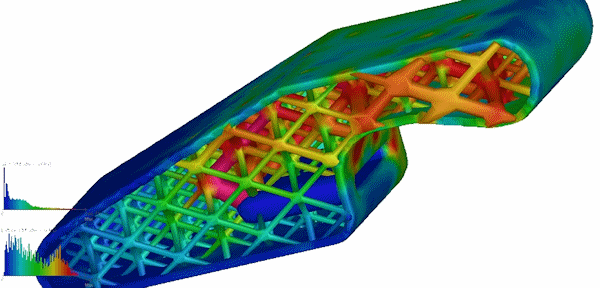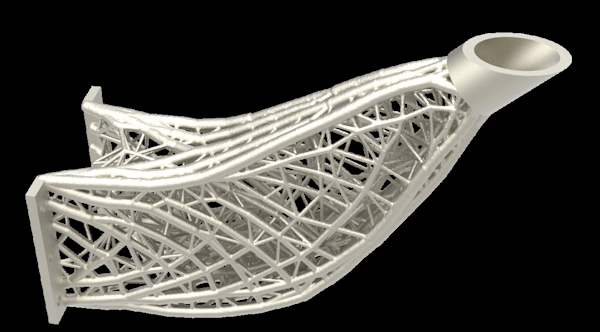Additive manufacturing technologies (such as 3D-printing and selective laser sintering) have already made waves in industry, but their greatest impact has yet to come – the revolution they will bring to design. Rather than discussing the very-Googleable advantages and disadvantages of Additive manufacturing (AM), we will focus on the implications of just one of its perks – the fact that with AM, the complexity comes for free.
A Simpler Time, or The Age of the Blocks
In modern component design, we take for granted the prevalence of simple geometries. Prismatic bodies, milled faces, turned curves, simple folds in sheet metal – all come to mind when we think ‘machine’. But what we often don’t realise is just how unnatural and alien these shapes really are – how preposterously divorced from nature the notion of a ‘straight line’ is. With rare exceptions (such as crystalline formations), nature is all curves and flourishes, and never like our mechanical components. But why?
The answer is what you’d expect: simple geometries are easy to design and manufacture. Making a plate with holes in it is not challenging, but making something skeletal (like a human pelvis) is. Inadvertently, our traditional tools of subtractive manufacturing have come to prescribe what forms our designs may feasibly take. Luckily, additive manufacturing does not.
Additive Manufacturing and the Defeat of Manufacturing Complexity
Wonderfully, AM does not care how complicated your geometry is. Layer by layer, it will build up a geometry regardless of how intricate it is. It can even do one better – it can make geometries that are traditionally impossible by subtractive means. Internal details, enclosed cavities, and even lattices and macroporosity are not only possible with AM, but come at no additional cost. The complexity comes for free.
While this in itself is exciting (and not without its own challenges; read The Thermal Challenge, later), what’s the big deal? The true value offered by AM is not in how it frees us from manufacturing constraints, but how it paves the way for truly complex design. The curves and flourishes of nature, the biomorphic web of the animal skeleton, the variable density of bone – all now are within the scope of the designer.

Design Set Free
While AM allows us to feasibly manufacture any complicated geometry we wish, it does not address the actual designing of complicated geometries. From the evolutionary approach of generative design (see http://blogs.autodesk.com/inthefold/generative-design-netfabb-2018/), we find that optimised designs have:
– Biomorphic primary structures (i.e. they are shaped like the webbing of a skeleton),
– Non-homogenously porous interiors (i.e. their interiors are denser where there is more stress, and less dense where there is less stress)

Using traditional design methods (read: bottom-up engineering), we are hilariously ill-equipped to meaningfully optimise either of these aforementioned features. For this level of complexity, a top-down approach is required – that is, we must feed the problem into the computer, and have it build our geometry for us. Sci-fi, right? Wrong. The tech is here now in the form of software such as Autodesk’s Netfabb (https://www.autodesk.co.uk/products/netfabb/overview).
Optimising primary and internal structures
On the surface, Netfabb is an AM software that allows users to set up builds for machines like 3D printers and selective laser-sinterers. However, its true power lies in its ability to optimise geometries using generative design. Not only can primary structures be optimised, but so too can the internal lattice-work. That’s right – Netfabb can analyse your parts using prescribed input forces, and redistribute the internal structure so that it is as light and as stiff as possible. This is non-trivial design. This is what has been made possible by the lifting of manufacturing burden by AM.
The Thermal Challenge
A lesser-known challenge in additive manufacturing (and particularly with metal AM) is the significant challenge of dealing with thermal stresses and deformation. As the layers of material are sintered or melted on top of each other, thermal stresses accumulate in the part, ultimately resulting in geometric warping. While this may seem like a woeful situation, there is a solution: to calculate how the part will warp during manufacture, and manufacturing a geometry that is counter-warped. That’s right, the part is printed deformed, and the warping induced by the AM process brings it to its proper geometry. You can be my guest in calculating how exactly to deform your design to achieve this effect, but know that Autodesk Netfabb does it for you. Yikes.
Final Notes on Netfabb
Autodesk are currently offering free trials of Netfabb, so if you want to get ahead of the game in AM and in generative design, be sure to check it out (https://www.autodesk.co.uk/products/netfabb/free-trial).
The paradigm shifts represented by advances in additive manufacturing and generative design are extremely daunting (if not philosophically troubling), but if you are serious about remaining development in design, I’d encourage you to take them seriously. Very soon, our current practices of traditional manufacturing and bottom-up design will seem as antique as blacksmithing and drawing boards.
Learning Nuevo
To bring you to the cutting edge of additive manufacturing and generative design, Man and Machine offer a wide range of products and services. As Autodesk Platinum Partners, we are not only able to offer such industry-leading products as Netfabb, but also provide world-class support, training and consultancy in their use. Contact us today, and let us help you to the forefront of industrial technology.
